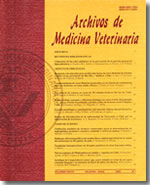A small herd sample to predict an active infection with bovine viral diarrhea virus (BVDV) in dairy herds of X Region, Chile
Main Article Content
Abstract
Bovine viral diarrhea virus (BVDV) has a worldwide distribution and most cattle are seropositive, although the prevalence may vary among herds and among different age groups. Persistently infected (PI) animals are the most efficient transmitters of infection often remaining unnoticed in the herds thus, becoming the most important source to perpetuate the infection. In each of the 44 dairy herds studied from X Region, Chile, ten young stock aged 6 _ 12 months were tested for antibodies against BVDV. In 35 dairy herds (79.5%) BVDV active infection was predicted because at least 6 over ten sera were antibody carriers. Thus, based on few blood samples, herds with PI animals and herds without PI animals could be distinguished with a high degree of accuracy.

